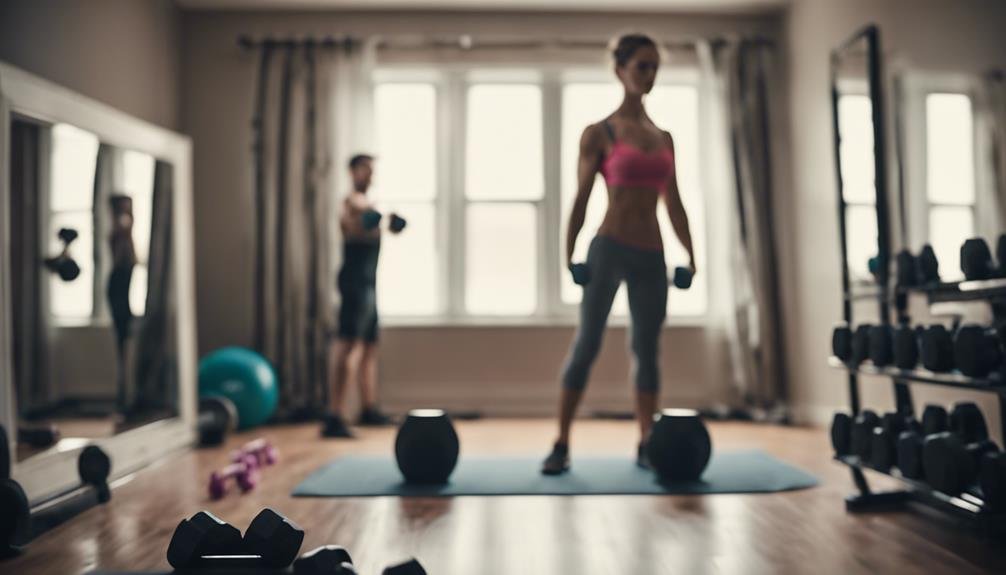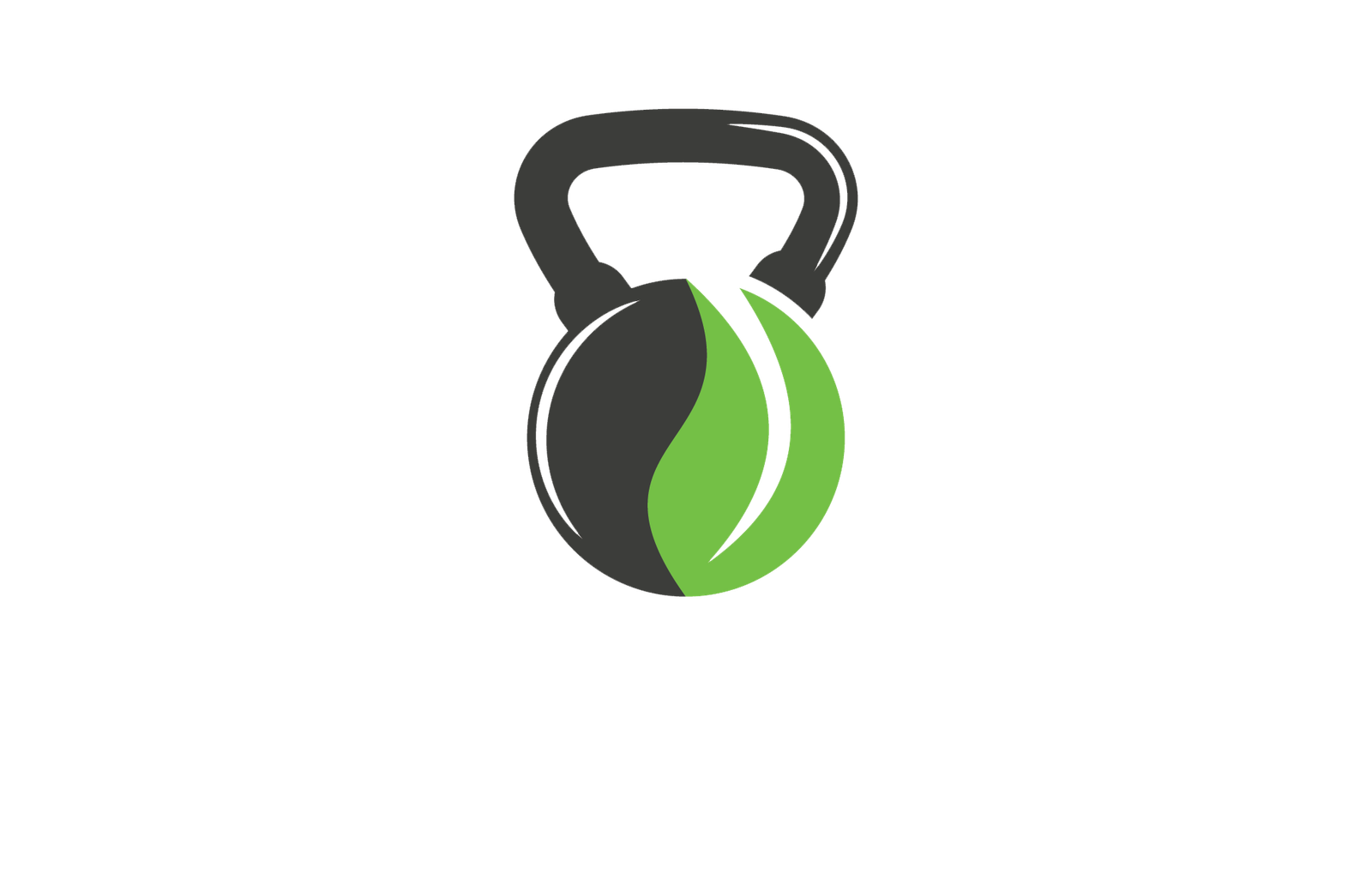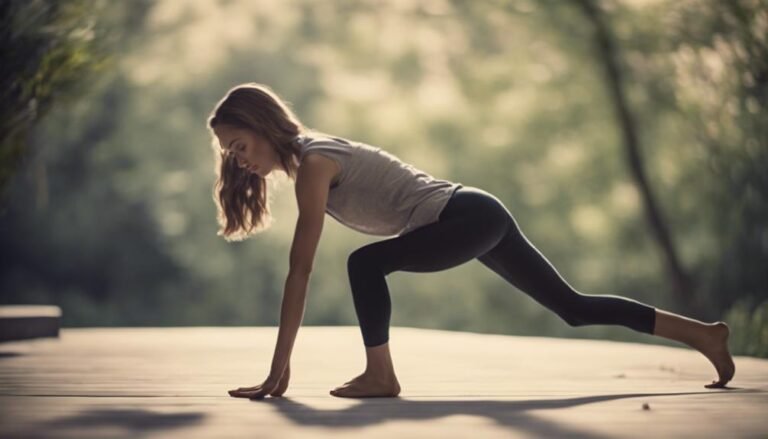Don't miss our holiday offer - 20% OFF!

Upper Body Strength Training Routines at Home
We're ditching gym memberships for the convenience of home workouts, where we can easily craft a stronger, more toned upper body with minimal equipment and a solid routine. A good set of dumbbells and a folding bench are must-haves for effective exercises like bicep curls, shoulder presses, and rows. We'll focus on exercises that target multiple muscle groups simultaneously, like push-ups, dumbbell presses, and tricep dips. With a progressive routine and incorporation of cardio, we'll be on our way to building definition and mass. As we get started, we'll discover more effective exercises and routines that'll take our upper body strength to the next level.
Key Takeaways
- Invest in essential equipment like dumbbells, kettlebells, and a folding bench for a versatile home gym.
- Prioritize upper body exercises like dumbbell rows, incline dumbbell press, and tricep dips for a well-rounded workout.
- Focus on exercises that target multiple muscle groups simultaneously, such as push-ups and rows, for an efficient workout.
- Incorporate progressive overload into workouts by gradually increasing intensity through added weight, reps, or sets over time.
- Utilize space-saving equipment like adjustable dumbbells and resistance bands, and optimize storage with wall-mounted shelves or hooks.
Essential Equipment for Home Workouts
We'll need a few essential pieces of equipment to get started with our home workouts, and a good set of dumbbells is the first must-have on our list. These versatile weights can be used for a variety of exercises, from bicep curls to shoulder presses, and are a great way to target our upper body. Another valuable addition to our home gym is a kettlebell. The kettlebell benefits extend beyond just strength training, as it can also improve our overall fitness and athleticism. We can use it to perform swings, cleans, and presses, which will engage our entire upper body. A folding bench is also a great investment, as it allows us to perform exercises like dumbbell presses and rows. It's also space-efficient, which is perfect for those of us with limited room at home. With these essential pieces of equipment, we'll be well on our way to building a solid upper body strength training routine in the comfort of our own homes.
Building a Home Gym on Budget
Building a home gym doesn't have to break the bank, as savvy shoppers can snag quality equipment at affordable prices with a little creativity and resourcefulness. We've learned that budgeting tips are key to building a home gym on a budget. To begin with, prioritize your needs: identify the most essential equipment for your upper body strength training goals. Then, shop smart by scouring online marketplaces, second-hand stores, and garage sales for discounted or used equipment.
When it comes to space optimization, we've found that multi-functional equipment is a game-changer. Consider investing in adjustable dumbbells or resistance bands that can be used for a variety of exercises, saving space and money. Additionally, utilize vertical space by installing wall-mounted shelves or hooks to store equipment, keeping your workout area clutter-free and organized. By being mindful of our budget and optimizing our space, we can create a functional and effective home gym that meets our fitness needs without breaking the bank.
Best Upper Body Exercises for Beginners
With our home gym setup and budget-friendly equipment in place, we can now focus on creating an effective upper body strength training routine, starting with the best exercises for beginners. As we begin our upper body strength training journey, mastering the fundamentals is crucial. We'll focus on exercises that target multiple muscle groups at once, ensuring a well-rounded workout.
Here are some essential upper body exercises for beginners:
| Exercise | Muscle Groups Targeted |
|---|---|
| Dumbbell Rows | Back, Shoulders, Biceps |
| Incline Dumbbell Press | Chest, Shoulders, Triceps |
| Bent Over Dumbbell Fly | Shoulders, Upper Back |
| Tricep Dips (using a chair or bench) | Triceps, Shoulders |
Push-Up Variations for Chest Strength
As we progress to more advanced exercises, incorporating push-up variations into our routine can substantially enhance chest strength and overall upper body development. Understanding chest anatomy is key to targeting the right muscle groups. The pectoralis major, comprising the sternal head and clavicular head, is responsible for movements like pushing and pressing.
To take our push-up game to the next level, we can try the following variations:
- Diamond Push-Ups: Place hands closer together than shoulder-width apart, with index fingers and thumbs forming a diamond shape. This variation targets the triceps and the clavicular head of the pectoralis major.
- Decline Push-Ups: Elevate your feet on a bench or stairs, increasing the angle of your body. This variation targets the lower chest muscles.
- Medicine Ball Push-Ups: Hold a medicine ball while performing a push-up, engaging the core and challenging overall stability.
These push-up progressions will not only improve chest strength but also increase overall upper body stability and endurance.
Effective Dumbbell Chest Exercises
As we move on to effective dumbbell chest exercises, we're excited to explore two essential movements that will help us build a stronger, more defined chest. We'll start with the Dumbbell Chest Press, a classic exercise that targets the pectoralis major muscle. Next, we'll discuss the Incline Dumbbell Fly, an exercise that specifically targets the upper chest muscles, helping to create a more balanced look.
Dumbbell Chest Press
We'll start with the dumbbell chest press, a staple exercise that effectively targets the chest muscles, particularly the pectoralis major. This exercise requires proper Chest Mechanics and Press Techniques to get the most out of it. To perform the dumbbell chest press, lie on a flat surface with your knees bent and feet planted firmly on the ground. Hold a dumbbell in each hand, with your arms extended overhead and your palms facing forward.
Here's what to focus on:
- Keep your core engaged to maintain a stable position and prevent arching your back.
- Lower the dumbbells to the sides of your chest, squeezing your chest muscles as you press upwards.
- Avoid letting your elbows flare out to the sides, instead, keep them in line with your shoulders.
Incline Dumbbell Fly
Targeting the upper chest muscles, the incline dumbbell fly is an effective exercise that helps improve overall chest development and adds variety to our chest workout routine. We love incorporating this exercise into our routine because it allows us to target the upper chest muscles from a different angle, which helps to create a more balanced chest development. To perform the incline dumbbell fly, we start by sitting on an incline bench with our feet planted firmly on the ground. We hold a dumbbell in each hand, with our palms facing each other. From there, we lift the dumbbells out to the sides, keeping our arms straight, and then lower them back down to the starting position. Maintaining proper fly form is crucial to avoid muscle imbalance and injury. We focus on squeezing our chest muscles at the top of the movement and taking a brief pause before lowering the dumbbells back down. By incorporating the incline dumbbell fly into our routine, we can guarantee a more thorough chest workout that targets all areas of the chest muscles.
Bodyweight Exercises for Shoulder Toning
As we focus on bodyweight exercises for shoulder toning, we'll explore how to isolate specific shoulder muscles to achieve definition and mass. We'll discuss exercises that target the deltoids, trapezius, and rotator cuff muscles, helping us build strength and stability. By incorporating these exercises into our routine, we'll be able to develop toned, well-defined shoulders that complement our overall upper body strength.
Shoulder Muscle Isolation
By incorporating specific bodyweight exercises into our routine, we can effectively isolate and tone our shoulder muscles, leading to improved overall upper body strength and stability. Understanding shoulder anatomy is key to targeting the right muscles. The rotator cuff, comprising the supraspinatus, infraspinatus, teres minor, and subscapularis muscles, plays a vital role in stabilizing the shoulder joint.
To isolate our shoulder muscles, we can try the following exercises:
- Lateral Raises: Stand with our feet shoulder-width apart, raise our arms out to the sides until they're at shoulder height, and lower them back down. This targets the deltoids.
- Front Raises: Stand with our feet shoulder-width apart, raise our arms straight out in front of us until they're at shoulder height, and lower them back down. This targets the anterior deltoids.
- Scapular Wall Slides: Stand with our backs against a wall, engage our core, and slide our shoulder blades up and down the wall. This targets the trapezius and rhomboids.
Building Definition and Mass
Now that we've isolated our shoulder muscles, we're ready to build definition and mass through bodyweight exercises that challenge our entire shoulder girdle. We'll focus on exercises that activate multiple muscle groups at once, ensuring a more efficient workout. Our progressive routine will target the deltoids, trapezius, and rhomboids, guaranteeing a stronger, more toned upper body.
Here's a sample workout routine to get us started:
| Exercise | Sets x Reps |
|---|---|
| Inverted Rows | 3 x 12 |
| Lateral Raises | 3 x 15 |
| Planks | 3 x 60s |
| Arnold Press | 3 x 10 |
| Superman | 3 x 12 |
Building Stronger Arms With Resistance
We can develop stronger, more toned arms with resistance training, which targets the biceps, triceps, and forearm muscles. This type of training is essential for overall upper body strength and can be done conveniently at home. With a few simple exercises and some resistance bands, we can achieve the toned arms we've always wanted.
Here are some exercises to get us started:
- Arm Circles: Hold a resistance band in both hands and perform small circles with our hands for 10-15 reps. This exercise targets the forearm muscles.
- Bicep Curls: Hold a resistance band in one hand and perform bicep curls for 10-15 reps. Switch hands and repeat.
- Tricep Extensions: Hold a resistance band in one hand and extend our arm straight behind us. Lower the band back down to the starting position and repeat for 10-15 reps. Switch hands and repeat.
Tricep Dips at Home Without Equipment
Performing tricep dips at home without equipment is a convenient and effective way to target our triceps, and with a little creativity, we can achieve a great workout using our own body weight. We can do this by using a sturdy chair, bench, or even the edge of our bed as a makeshift dip station. To start, we'll place our hands on the edge of the surface with our feet flat on the floor, then lower our body by bending our elbows until our arms are bent at a 90-degree angle. We'll straighten our arms to return to the starting position, squeezing our triceps at the top of the movement. For a variation, we can try diamond dips by placing our hands closer together, or we can elevate our feet to increase the difficulty. If dips aren't our thing, we can try dip alternatives like tricep push-ups or overhead tricep extensions. By incorporating these tricep variations into our routine, we can strengthen our upper body and improve overall fitness.
DIY Pulley System for Home Workouts
As we explore the DIY pulley system for home workouts, we're excited to share the essential components that make up this effective training tool. We'll break down the necessary parts, from the pulley wheel to the rope or cable, so we can understand how they work together to target our upper body muscles. By grasping these fundamentals, we can confidently create our own DIY pulley system and take our home workouts to the next level.
Pulley System Components
In setting up a DIY pulley system for home workouts, four essential components are required: a pulley wheel, a cable, a weight, and an anchor point. These components work together to provide a smooth and effective workout experience, similar to what you'd find on commercial cable machines at the gym.
Here's a breakdown of each component:
- Pulley wheel: This is the wheel that the cable wraps around, allowing for a smooth and consistent motion.
- Cable: This is the rope or cord that connects the weight to the pulley wheel, providing the resistance needed for a great workout.
- Weight: This is the load that provides the resistance, which can be adjusted to suit your fitness level.
DIY Installation Tips
We attach our pulley wheel to a sturdy anchor point, securing it firmly to withstand the weight and tension of our workout routine. To guarantee a safe and effective installation, we use wall anchors specifically designed for heavy loads. We make sure to follow the manufacturer's instructions for proper installation, taking drill safety into consideration to avoid accidents.
Next, we focus on cable management, carefully routing the cables to avoid tangles and kinks. We design a shelf with a clever cable management system, keeping the cables organized and out of the way. This not only enhances the overall aesthetic but also prevents damage to the cables.
Before finalizing the installation, we double-check our work using leveling tools to verify everything is perfectly aligned. This attention to detail guarantees a smooth and safe workout experience. By following these DIY installation tips, we can confidently create a professional-grade pulley system in the comfort of our own homes, ready to take our upper body strength training to the next level.
Creating a Full-Body Workout Routine
By incorporating exercises that target multiple muscle groups, we can create a full-body workout routine that's both efficient and effective. This approach allows us to work multiple muscle groups simultaneously, saving time and energy while still achieving our fitness goals.
Here are some key components to include in our full-body workout routine:
- Core stabilization exercises: These exercises, such as planks and bird dogs, help improve our overall core strength and stability.
- Muscle balancing exercises: Exercises like push-ups and rows help balance our muscle strength, ensuring that no single muscle group becomes overdeveloped.
- Compound exercises: Exercises like squats and lunges work multiple muscle groups at once, making them a great addition to our full-body workout routine.
Incorporating Cardio Into Strength Training
As we shift our focus to incorporating cardio into our strength training, a well-rounded fitness routine should strike a balance between building muscle and improving cardiovascular endurance, which is essential for achieving overall fitness, and is necessary to enhance our overall athleticism. We can incorporate cardio exercises into our strength training routine by adding High Intensity Intervals (HIIT) to our workouts. HIIT involves short bursts of intense exercise followed by brief periods of rest. For example, we can do a set of burpees, followed by 30 seconds of rest, and then repeat for 15-20 minutes. Another way to incorporate cardio is by adding Cardio Blasts to our strength training exercises. Cardio Blasts involve adding a cardio component to our strength exercises, such as jumping jacks between sets of push-ups or squats. By incorporating cardio into our strength training, we can improve our cardiovascular endurance, increase our caloric burn, and enhance our overall fitness level.
Progressive Overload for Muscle Growth
To build significant muscle mass, our workout routine must incorporate progressive overload, a training principle that involves gradually increasing the intensity of our workouts by adding weight, reps, or sets over time. This is essential because our muscles adapt quickly, and if we don't challenge them, they won't grow. We need to push ourselves beyond what we're capable of to stimulate muscle growth.
To achieve progressive overload, we can make micro progressions in our workouts. Here are a few ways to do it:
- Increase the weight we lift by 2.5-5lbs every two weeks
- Add an extra rep or set to our exercises
- Decrease rest time between sets and exercises to increase overall intensity
Sample Workout Routine for Busy Days
On days when time is scarce, we can still fit in an effective upper body strength training session with a condensed routine that targets multiple muscle groups simultaneously. This is especially useful for busy mornings when we need a Quick Fitness fix to get us going for the day.
Our sample workout routine for busy days consists of just three exercises: push-ups, dumbbell rows, and bicycle crunches. We'll do three sets of 12 reps for each exercise, resting for 60-90 seconds between sets. This routine targets our chest, back, shoulders, and core, giving us a solid upper body workout in just 20 minutes.
To make the most of our Morning Routines, we'll focus on proper form and engage our core muscles to maximize the effectiveness of each exercise. By incorporating this condensed routine into our busy days, we can maintain our upper body strength and still have time for our daily responsibilities. With a little creativity and time management, we can fit in a great workout even on the most hectic days.
Frequently Asked Questions
Can I Do Upper Body Strength Training With an Injury or Chronic Pain?
When dealing with injuries or chronic pain, we modify exercises to prioritize pain management, incorporating safe adaptations, gentle stretches, and low-impact options to facilitate a safe and effective workout.
How Often Should I Rest and Recover Between Workout Sessions?
As we navigate the sphere of fitness, akin to medieval knights seeking the Holy Grail, we find that allowing for adequate rest windows and adhering to recovery timelines is vital, lest we risk burnout and injury, and ideally, every 48-72 hours, we take a breather.
What Is the Ideal Workout Duration for Effective Upper Body Training?
We find that ideal timing is key to effective workouts; aiming for 30-45 minute efficient sessions allows us to push ourselves without burnout, ensuring we're making the most of our time and energy.
Can I Substitute Dumbbells With Household Objects for Strength Training?
We can substitute dumbbells with household objects; for instance, a water bottle can add resistance to our arm curls, while a couch push-up targets our triceps, making creative strength training possible anywhere!
Is It Necessary to Warm up Before Starting an Upper Body Workout Routine?
We always prioritize proper preparation by warming up before any workout, as diving into exercises with a cold muscle increases the risk of injury. It's a must for peak performance and safety.
Conclusion
As we wrap up our upper body strength training routines, we've pumped up our knowledge and power. We've pushed past procrastination, pressed into progress, and propelled ourselves towards a stronger, sleeker physique. By incorporating these exercises and tips into our daily grind, we'll be flexing our muscles in no time, feeling fierce and fantastic. So, let's keep lifting, learning, and leveling up – our fitness journey has just begun!



